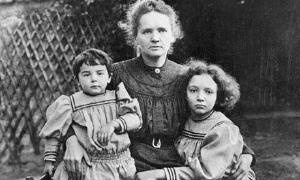Blog
Legacy
11 May 2014
 Wellcome Library
Wellcome LibraryMarie Skłodowska-Curie was a pioneer in the study of radioactivity. She in fact coined the term. She developed a method for isolating radioisotopes, and discovered two elements (radium and polonium). She worked on radiation therapy of tumors, and established military radiological centers during World War I. She is the only person ever to have won a Nobel prize in two scientific fields (Physics in 1903, and Chemistry in 1911). She also happened to be the mother of two daughters.
Her youngest daughter, Ève, became a writer and journalist. Her eldest daughter Irène became a chemist. Irène’s research focused on the structure of the atom, and her research discovered the neutron, which along with the electron and proton were considered elementary particles at the time. She was awarded the Nobel prize in Chemistry in 1935 for her work on the transmutation of elements. By bombarding elements with alpha particles, she was able to create nitrogen from boron, and later phosphorus from aluminum and silicon from magnesium. Since the resulting elements were radioactive, they provided a ready source of radioisotopes needed for medicine and medical research.
Irène also had two children. Her son Pierre became a biologist, and her daughter Hélène became a physicist. Hélène is a professor of nuclear physics at the University of Paris, and has continued research in the field her mother and grandmother helped create. It is a field that has become crucial to astrophysics, and plays a role in everything from the fusion of elements in the core of a star, to the rate at which a supernova dims. Our understanding of the universe would be greatly diminished were it not for the work of Marie, Irène, and Hélène.
Marie Curie’s work on radioactivity was a monumental achievement, and through her daughters and grandchildren she founded a legacy of scientists. It’s a legacy worth celebrating on Mother’s day, or any day for that matter.